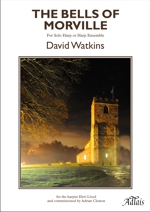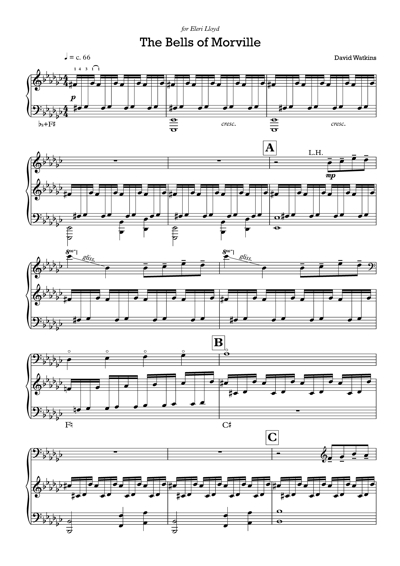 |
|||
| |
of Harp Music |
| © 2004-2025 ADLAIS |
| The Bells of Morville David Watkins |
return to previous page |
 |
Work: | Solo
harp With suggestions for division for ensemble performance |
| Catalogue No: | Adlais 217 | |
| ISMN: | 979-0-57032-223-7 | |
| Edition: | February 2016 A4 stapled | |
| Duration: | c. 12.15 minutes | |
| Suitable for: | Grade 6-7, Pedal Harp | |
| Price:: | £10.00 Go to shop | |
| The Bells of Morville |
THE BACKGROUND When I lived near Oswestry, I often passed through Morville on my way to London. On one occasion, I surreptitiously ventured through the gate pillars and under the lime avenue to glimpse the beautiful juxtaposition of the Hall to its two pavilions and the mediaeval church. It was only later that a dear friend gave me the “Morville Hours” by Katherine Swift and, after meeting her, my fascination with Morville grew. She inspired me, not only with her insights into gardening and its history, but with her perceptive understanding of the Shropshire landscape and the origins of Morville with its Benedictine monastery. I gave a harp recital in the extraordinary acoustics of the mediaeval church, and became aware of the magnificent set of bells in the tower. The Tower Captain, Ian Rowe, introduced me to the bells during a weekly bell ringing practice, and after a short spell in the bell chamber I returned home so excited that I could hardly sleep. It was then that a work for the harp (or harps) juxtaposed with the bells of Morville started to emerge. THE PROGRAMME As the sound of the bells fades, the harps quietly emerge, becoming stronger and stronger until at the highest point a peal of harp notes rings out loudly, eventually dying away to nothing. In the silence, alleluias are heard reminding us of the monks who sang in this church. To mediaeval ears the Alleluia was the overpowering expression of the ecstasy of the spirit, a joy that could not be restricted to words and brought with it a feeling of the cleansing of the soul. This Alleluia “Vere tu es Rex” (‘Indeed thou art King’) was sung for the Feast of the Holy Family. These Alleluias then mutate, combining with bell-like scales and a chorale to welcome the birth of Jesus. Three versions of the ‘Coventry Carol’ follow. This astonishingly beautiful lullaby dates from the fifteenth century and seems to have been first performed at the Pageant of Shearmen and Tailors in Coventry. It is a lullaby for the Christ child but we are reminded to be vigilant at Herod’s calculated treachery. The intimate and heartfelt lullaby is soon transformed into the joyful and dance-like “Angelus ad Virginem” (‘The Angel unto Mary’). It was very popular in fourteenth century England and Chaucer mentioned it in his “Miller’s Tale”. There it is sung by Nicholas, the Clerk of Oxenford, who accompanies himself on the psaltery.
The musical excitement continues to build up and is transformed into the fifteenth century German carol “Puer Nobis Nascitur”
The work finishes with brilliant and loud glissandi up and down the harps and then the eight bells of Morville come crashing in with joyful abandon. THE FIRST PERFORMANCE The Bells of Morville was performed for the first time at St Gregory’s Church, Morville on St Cecilia’s Day, the 22nd November 2014. Although the work was composed for a solo harpist, it sounds more fascinating and is easier when played by a harp ensemble. We were four harpists for this performance: Eleri Lloyd (the dedicatee), Helen Barley, Frank Sternefeld, and David Watkins. More harpists could be involved and could also be joined by lever harpists in some of the sections. An mp3 recording of the bells is included with the score but can also be downloaded from just below – and, most helpfully, the bells are tuned in Gb major! A CD of the first performance could be a useful guide and is available separately from Creighton's Collection. Everybody plays from the solo score and the performance notes at the end of the score will give suggestions for division and augmentation. BELL TRACKS FOR LIVE PERFORMANCE
|
BELL TRACKS FOR LIVE PERFORMANCES See Performance notes in section above. |

